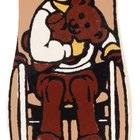
"Mother and baby, red" is Copyrighted by Flickr user: sylvar (Ben Ostrowsky) under the Creative Commons Attribution license.
Day care programs, as they’re recognized today, began in the late 19th century. The first establishments were private and fee paying, and they received only limited public support. The government began sponsoring child care programs as part of the New Deal in response to the calamity of the Great Depression. These programs continued through World War II before being replaced by a series of subsidies linking government-sponsored child care to welfare reform. Today, the majority of child care programs are for-profit.
The First Day Nursery
The first day nursery was established in 1893 by prominent New York philanthropist Josephine Jewell Dodge. Her intent was to draw attention to the need for child care and to showcase approved methods for successfully raising children. Not everyone approved of Ms. Dodge’s mission. Opponents claimed that day nurseries encouraged women to take low-paid jobs while their children suffered from inadequate care. In response, the U.S. Children’s Bureau introduced the “mother’s pension” program to support mothers so they could stay at home with their children. While popular, the program did nothing to address the child care problems faced by low-income mothers who had no choice but to go out to work.
The Great Depression and the New Deal
The Depression affected the history of day care in several ways. As unemployment rose, enrollment in private, fee-paying day nurseries declined, forcing almost one in four establishments to close. At the same time, the Works Progress Administration, a key New Deal work-relief agency, established a program of Emergency Nursery Schools as a way to give employment opportunities to unemployed teachers. By 1935, these free, government-sponsored facilities had part-time capacity for approximately 75,000 children of the unemployed.
World War II
As mothers sought employment in war-related industries, the need for child care rose to unprecedented levels. Congress allocated $6 million to convert the limited Emergency Nursery Schools program into public child care facilities for every working mother. Plagued by red tape and a lack of public support for working mothers, the program managed to provide day care for just 130,000 children, far short of the 2 million places that were needed. Funding was cut off shortly after the end of World War II, forcing most of the centers to shut down.
History of Day Care Post World War II
In 1954, Congress introduced the child care tax deduction, which gave low- to moderate-income families the ability to deduct their child care expenses from their income taxes. While welcome, the measure failed to address issues such as the supply and affordability of quality child care, most of which was still provided by the charitable sector. In 1958, the Inter-City Committee for Day Care of Children began lobbying to gain federal support for public day care, stressing the need for safeguarding children in the light of rising maternal employment. Government remained ambivalent. Even the Kennedy administration, which was largely sympathetic to the plight of working mothers, could not muster the political support needed to push through a comprehensive child care system.
Modern-Day Welfare Reforms
From the 1960s to the 1990s, federal sponsorship of child care was linked to policies designed to reduce the number of Americans receiving welfare benefits. As a result, low-income families could access subsidized child care as a means of being able to work. At the same time, middle-class families could use child care costs to reduce personal income taxes. In the 1980s, the Reagan administration cut expenditures for low-income families while doubling those that benefited higher income families. These measures boosted the provision of for-profit child care. The Child Care and Development Fund became the primary source of government funding for child care subsidies for low-income working families.
Related Articles

Traditional Roles of Men & Women in ...

Facts About Orphans

What Were the Traditional Gender Roles ...

What Is the Difference Between Licensed ...

List of Charitable Organizations in Ohio

Child Runaway Laws

Pennsylvania Grants for Adopted Children

Federal Government Grants for Child Day ...

Who Gives Donated Vehicles to the Poor?

Disciplining Children in the 1950s

About Kids in Colonial Times

Vitamin B6 Dosing for Children

How Much Are Monthly Disability ...

Description of a Child Care Center

Technology Used in Day Care Centers

Chasteberry for Acne

Uses, Advantages and Doses of Castor Oil

The History of Converse Shoes

Facts About Air Jordan Shoes

Ontario Grants for Family to Care for ...
References
Writer Bio
A former corporate real estate lawyer, Jayne Thompson writes about law, business and personal finance, drawing on 17 years’ experience in the legal sector. She holds a Bachelor of Laws from the University of Birmingham and a Masters in International Law from the University of East London. Her work has appeared on numerous legal blogs including Quittance, Upcounsel and Medical Negligence Experts. Find her at www.whiterosecopywriting.com.